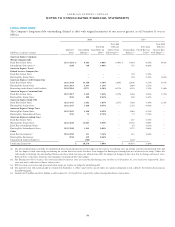American Express 2011 Annual Report Download - page 77
Download and view the complete annual report
Please find page 77 of the 2011 American Express annual report below. You can navigate through the pages in the report by either clicking on the pages listed below, or by using the keyword search tool below to find specific information within the annual report.
AMERICAN EXPRESS COMPANY
NOTES TO CONSOLIDATED FINANCIAL STATEMENTS
NOTE 8
OTHER ASSETS
The following is a summary of other assets as of December 31:
(Millions) 2011 2010
Goodwill $ 3,172 $ 2,639
Deferred tax assets, net(a) 2,875 3,397
Prepaid expenses(b) 2,378 1,802
Other intangible assets, at amortized cost 1,149 972
Derivative assets(a) 915 1,071
Restricted cash(c) 584 4,172
Other 1,582 1,315
Total $ 12,655 $ 15,368
(a) Refer to Notes 17 and 12 for a discussion of deferred tax assets, net, and
derivative assets, respectively, as of December 31, 2011 and 2010. Derivative
assets reflect the impact of master netting agreements.
(b) Includes prepaid miles and reward points acquired primarily from airline
partners of approximately $1.8 billion and $1.2 billion, as of December 31,
2011 and 2010, respectively, including approximately $1.5 billion and $0.8
billion, respectively, from Delta.
(c) Includes restricted cash of $0.2 billion and $3.7 billion, respectively, as of
December 31, 2011 and 2010, which is primarily held for certain asset-
backed securitization maturities.
GOODWILL
Goodwill represents the excess of acquisition cost of an acquired
company over the fair value of assets acquired and liabilities
assumed. The Company assigns goodwill to its reporting units
for the purpose of impairment testing. A reporting unit is
defined as an operating segment, or a business that is one level
below an operating segment for which discrete financial
information is regularly reviewed by the operating segment
manager. The Company evaluates goodwill for impairment
annually as of June 30 and between annual tests if events occur
or circumstances change that would more likely than not reduce
the fair value of the reporting unit below its carrying value. The
goodwill impairment test utilizes a two-step approach. The first
step identifies whether there is potential impairment by
comparing the fair value of a reporting unit to the carrying
amount, including goodwill. If the fair value of a reporting unit
is less than its carrying amount, the second step of the
impairment test is required to measure the amount of any
impairment loss. As of December 31, 2011 and 2010, goodwill
was not impaired and there were no accumulated impairment
losses.
Goodwill impairment testing involves management judgment,
requiring an assessment of whether the carrying value of the
reporting unit can be supported by its fair value using widely
accepted valuation techniques. The Company uses a
combination of the income approach (discounted cash flow
method) and market approach (market multiples).
When preparing discounted cash flow models under the
income approach, the Company uses internal forecasts to
estimate future cash flows expected to be generated by the
reporting units. Actual results may differ from forecasted results.
The Company uses the expected cost of equity financing,
estimated using a capital asset pricing model, to discount future
cash flows for each reporting unit. The Company believes the
discount rates used appropriately reflect the risks and
uncertainties in the financial markets generally and specifically in
the Company’s internally developed forecasts. Further, to assess
the reasonableness of the valuations derived from the discounted
cash flow models, the Company also analyzes market-based
multiples for similar industries of the reporting unit, where
available.
The changes in the carrying amount of goodwill reported in the Company’s reportable operating segments and Corporate & Other were
as follows:
(Millions) USCS ICS GCS GNMS
Corporate &
Other Total
Balance as of January 1, 2010 $ 175 $ 512 $ 1,547 $ 28 $ 66 $ 2,328
Acquisitions(a) – – – 131 184 315
Dispositions – – (2) – – (2)
Other, including foreign currency translation – (1) (1) – – (2)
Balance as of December 31, 2010 $ 175 $ 511 $ 1,544 $ 159 $ 250 $ 2,639
Acquisitions(b) – 538 – 1 20 559
Dispositions – – (1) – – (1)
Other, including foreign currency translation – (26) – – 1 (25)
Balance as of December 31, 2011 $ 175 $ 1,023 $ 1,543 $ 160 $ 271 $ 3,172
(a) Comprised of $131 million and $184 million for the acquisition of Accertify Inc. and Revolution Money Inc., respectively. Refer to Note 2 for further discussion.
(b) Primarily comprised of $538 million for the acquisition of Loyalty Partner. Refer to Note 2 for further discussion.
OTHER INTANGIBLE ASSETS
Intangible assets are amortized over their estimated useful lives
of 1 to 22 years. The Company reviews intangible assets for
impairment quarterly and whenever events and circumstances
indicate that their carrying amounts may not be recoverable. In
addition, on an annual basis, the Company performs an
impairment evaluation of all intangible assets by assessing the
recoverability of the asset values based on the cash flows
generated by the relevant assets or asset groups. An impairment
is recognized if the carrying amount is not recoverable and
exceeds the asset’s fair value.
75
























